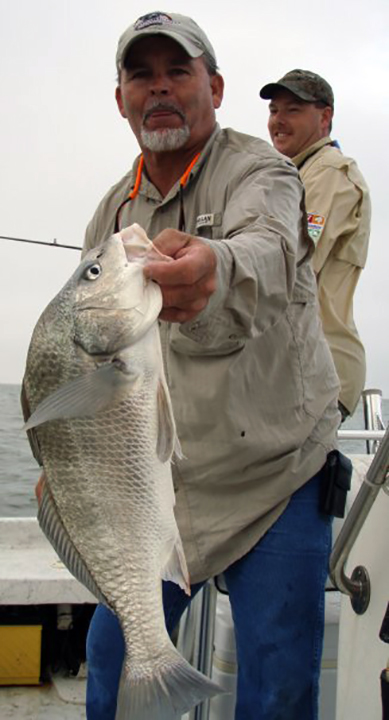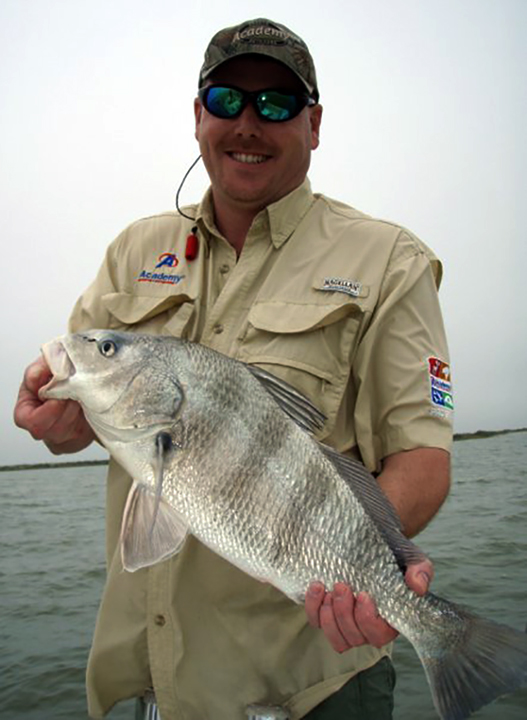Black drum aren’t a sexy saltwater species in Texas, playing second and even third fiddle to speckled trout, redfish and flounder. However, you won’t find a fish more fit for the dinner table, and even in the dead of winter these fish pack a punch on conventional tackle.
These cousins of the redfish (red drum) and croaker are equal-opportunity vacuum cleaners with a penchant for inhaling a variety of natural baits, including shrimp, crabs and mantis shrimp. During the winter they also frequent pier and jetty areas, as well as natural passes and manmade cuts that don’t require a boat to access.
One notable characteristic of this family of fish is an ability to produce differing sounds with the air bladder, the obvious reason for being named croaker and drum. I’ve also heard of anglers in boats being able to hear these distinctive sounds as big schools of “bull” drum pass nearby.
Simply put, the black drum is the saltwater target for the masses, and this time of year the fishing can be nothing short of exceptional when the fish are skirting the deep channels of the Intracoastal Waterway and moving up shallower when the temperatures rise.
Unlike redfish, which offer darting runs and surging pulses after inhaling a hooked barb, black drum react with a plodding, almost methodical pace after being hooked. They’ll shake their thick heads back and forth, offering short zig-zagging motions while testing your drag. But don’t let that presence fool you — these fish are strong. Even a “butterfly” or “puppy” drum as they’re sometimes called can peel drag with the best of the saltwater species.

If you’re looking to locate the ideal black drum habitat, the Laguna Madre (Mother Lagoon) that stretches from Corpus Christi southward down to Port Isabel is your best choice. The Laguna is hands-down the top spot for black drum when discussing angler access, with miles of prime habitat accessible by car, truck and on foot.
The section of road from the Flour Bluff area of Corpus Christi to North Padre Island, in particular, offers exceptional drive-up winter fishing for drum, with a number of piers and other access points to sling out multiple baits.
While the state record on rod and reel is an 81-pound fish caught in the summer of 1988 from the Gulf of Mexico, that doesn’t mean there aren’t still brutes skulking around in the winter. These fish will gang up before the spawn that occurs into the spring and it’s not uncommon to see scores of anglers frequenting beach areas near passes and other manmade flows targeting fish with a variety of natural baits.
It’s also not uncommon for anglers to land huge fish, including 30-, 40-, and even 50-pound specimens, and for anglers looking to land what likely will be the largest fish of their lifetimes, the black drum is the perfect angling target.
It should be noted that the daily bag for black drum is five fish and like redfish there’s a slot limit, this one spanning 14 inches to 30 inches. You also can keep one black drum longer than 52 inches as part of the daily bag, but those fish’s flesh is extremely coarse and almost always contain parasitic “spaghetti” worms, so it’s not advised to bring them home.
I’ve caught black drum in a variety of saltwater locales and habitats along the Texas coast, highlighting just how common the fish are, as well as how quickly they can adapt to weather and water conditions. I’ve caught them on live and dead shrimp in the back shallows of Aransas Bay during the spring, as well as on paddetail plastics over deeper oyster reefs. I’ve also caught drum on the same baits in the Landcut area south of Corpus Christi during the summer, in addition to finding the fish during the winter in other notable Upper Laguna hot spots including the Humble Channel.
Texas inshore saltwater fishing outstanding during fall, winter months
As noted by state biologists, black drum will spawn in either bays or the Gulf, or in connecting passes. That differs from speckled trout, which spawn only in the bays, and redfish, that spawn only in the Gulf, according to the Texas Parks & Wildlife Department. Drum also aren’t as susceptible to colder water temperatures, which can kill other species more quickly if freeze events occur.
Here’s another fun fact: while black drum are attracted to the freshwater runoff of creeks and rivers, they also can live in waters twice as salty as the Gulf, according to TPWD.
Black drum are the calling card for many fishing guides through the winter as they seek to put clients on fish, and if the speckled trout and redfish aren’t biting, drum can be a good option mostly due to their schooled-up presence and ease of fishing technique.
When discussing black drum fishing technique and tackle, it’s all about keeping things simple, especially if you plan to fish from a pier or jetty, or just from the shore near a channel. Similar to catching catfish in freshwater locales, the typical fishing rig for black drum is one that’s left near the bottom, and typically includes a bait that’s easy to locate by smell. That means you more than likely will be using sinkers or split shots to keep your freshly dead shrimp or cracked crab on the bottom. If there’s current in the deep hole you’re fishing, you also might need to go up on the weight of your sinkers.
Most of the time, medium-action spinning tackle works well for fish up to 30 pounds, but once you start talking about a fish that might tip the scales at 50 pounds, you also should plan to bring some stouter rods in addition to your regular setups. It’s not uncommon in the winter to see folks with 8- or 10-foot surf rods on piers, simply because they provide more backbone and leverage should you hook a jumbo-size bull drum.
While rod selection may vary, and you certainly should use whatever you’re comfortable with, your hook selection should be exact — circle hooks. Circle hooks initially came about because commercial fishermen needed a hook that would set itself, which is exactly what all circle hooks do. There’s no need at all to do the “hook-set jerk,” and in fact, that motion typically pulls your bait away from a fish that may have had its intentions on swallowing it.
The size of your circle hook selection should be large, especially since there’s a real possibility of finding a behemoth on the end of your line. The gap should be wide enough to find purchase in the big mouth of a large drum, and if you’ve done things correctly, once the fish has picked up your bait and moved off, it will pull the barb right into the side of the fish’s jaw. After that, it’s up to you to just hold on, reel up and fight your catch.
It should be noted that because circle hooks do a perfect job of setting in the side of a fish’s mouth, they are excellent for catch and release, especially if you land a 4-foot-long black drum.
January Fishing Tip
- Because of their strength, many anglers utilize a stout leader, which can aid in subduing especially large fish that can top 30 or 40 pounds easily this time of year.
Other January Fishing Hot Spots in Texas
- Choke Canyon Reservoir Catfish: Target shallow areas (8 feet or less) of flooded terrestrial vegetation with natural and cut bait.
- Amistad International Reservoir Largemouths: Topwaters, buzzbaits and spinner baits work well in early morning and late evening.


















